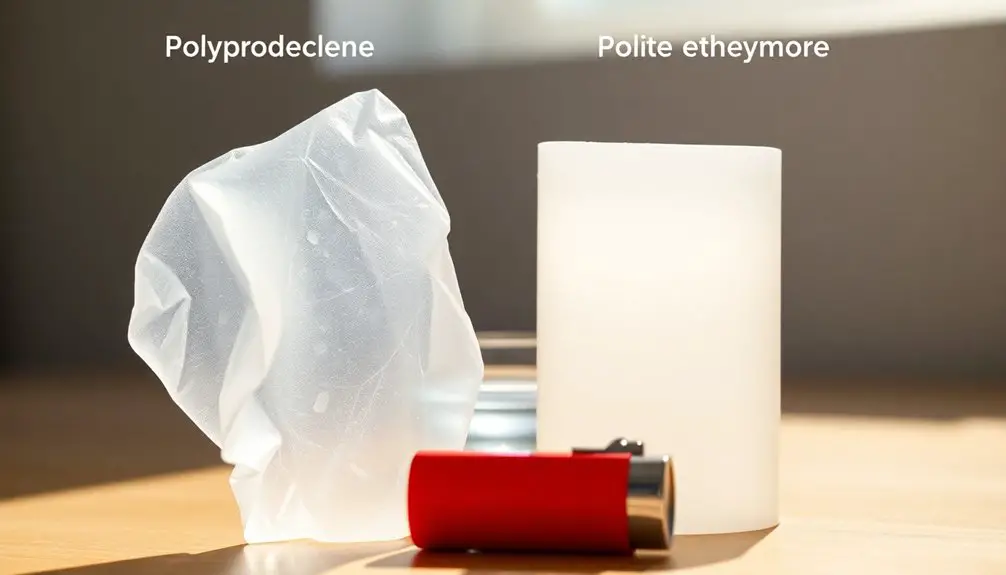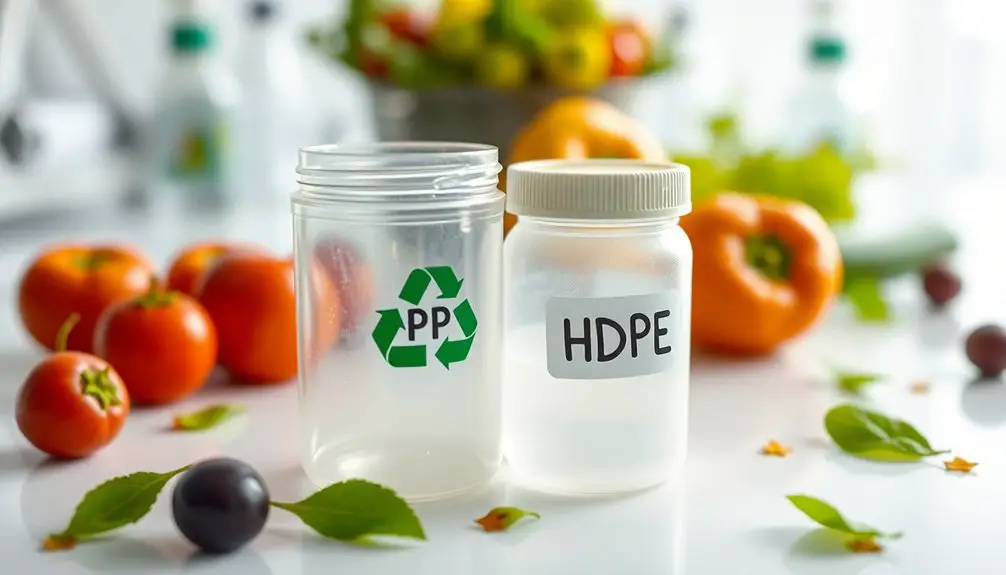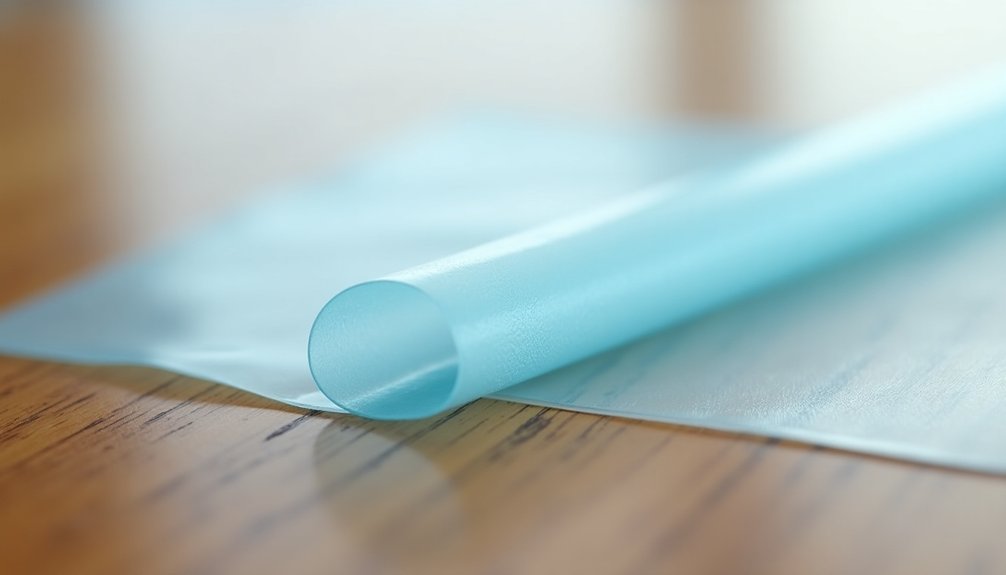To tell polypropylene (PP) from polyethylene (PE), start by noting their texture and firmness. PP is stiffer and less flexible, while PE is softer and more pliable. Conduct a burn test; PP produces a blue flame with a sweet smell, whereas PE gives a yellow flame with a waxy odor. PP will sink in water due to its density, while PE often floats. Look for recycling symbols: PP has a #5, while PE features #1 (PETE) or #2 (HDPE). Understanding these differences can help, and there's even more interesting information on identifying these plastics.
Key Takeaways
- Perform a burn test: PP produces a blue flame and sweet smell, while PE gives a yellow flame and waxy odor.
- Conduct a density test: PP has a specific gravity of 0.946 and sinks, whereas PE often floats due to varying densities.
- Observe flexibility: PE is more flexible and crinkles easily, while PP is stiffer and does not bend easily.
- Use a crease behavior test: Bending PP creates a white crease; PE does not show any crease when bent.
- Inspect visually: PP appears more opaque with a waxy surface, while PE is usually translucent or opaque.
Overview of Plastic Types
When considering the various types of plastics, it's essential to understand the key differences between them. Two prominent types are polyethylene and polypropylene, each with unique characteristics and applications.
Polyethylene (PE) is a flexible and soft plastic, commonly found in packaging materials. It comes in two main forms: Low-Density Polyethylene (LDPE) for bags and containers, and High-Density Polyethylene (HDPE), which you'll see in bottles and piping.
On the other hand, polypropylene (PP) is stiffer and harder, making it ideal for automotive components and textiles. It boasts a high melting point compared to polyethylene, which contributes to its strength and chemical resistance. This is why you often find polypropylene in food containers, medical supplies, and durable household items.
Additionally, the difference between LDPE and HDPE plays a significant role in determining their applications, as HDPE is widely used for containers and piping due to its higher tensile strength.
To identify different types of plastic, look for their recycling codes. Polyethylene is marked with #1 (PETE) and #2 (HDPE), while polypropylene is tagged with #5.
Understanding these differences helps you choose the right plastic for your needs and supports effective recycling practices.
Key Identification Methods
Identifying polypropylene and polyethylene can be straightforward with the right methods. One effective approach is the burn test. When you burn polypropylene, it produces a blue flame and a sweet smell, while polyethylene burns with a yellow flame and gives off a waxy odor.
Density tests are another reliable method. Polypropylene, with a specific gravity (SG) of 0.946, floats in water. Although polyethylene may also float, its SG varies slightly, especially between low-density (LDPE) and high-density (HDPE) types.
You can also employ a solvent test. Polypropylene resists common solvents, showing no signs of damage, whereas polyethylene might soften or discolor when exposed to certain chemicals.
Don't overlook visual inspection; polypropylene is generally stiffer and harder, while polyethylene tends to be more flexible and softer.
Additionally, the crease behavior test can help: polypropylene will show a white crease when bent, while polyethylene won't exhibit this property.
These methods focus on the chemical makeup and physical characteristics of the plastics, allowing you to accurately identify whether you're dealing with polypropylene or polyethylene.
To accurately identify the plastics, you should also be aware of the resin identification code, especially the polypropylene recycling code (#5) which can be found on the product itself, and is gaining acceptance in local recycling guidelines.
Visual and Physical Tests

Visual and physical tests are essential tools for distinguishing between polypropylene and polyethylene. Start with a visual inspection: polyethylene often appears translucent or opaque, while polypropylene tends to be more opaque with a waxy surface.
If you have access to samples, perform the burn test. When burned, polyethylene produces a yellow flame and a waxy smell, whereas polypropylene burns with a blue flame and a yellow tip, emitting a sweet scent.
Next, manipulate the materials to notice their textures. Polyethylene is flexible and crinkles, making a crackling sound, while polypropylene is more rigid and doesn't bend easily. This tactile difference can help you identify the type of plastic.
Finally, consider the float test. Place a piece of each plastic in water; polyethylene, due to its lower density, will float, while polypropylene will sink. When it comes to using plastics in greenhouse construction, understanding the properties of thermal insulation is crucial for maintaining optimal growth conditions and protecting plants from frost.
Each of these tests provides a practical way to differentiate between these two common plastics, enabling you to identify them accurately in various applications. By using these visual and physical tests, you can confidently tell polypropylene from polyethylene.
Environmental Considerations
Environmental considerations play a crucial role in the discussion of polypropylene (PP) and polyethylene (PE). Understanding their environmental footprints can help you make informed choices.
| Factor | Polypropylene (PP) | Polyethylene (PE) |
|---|---|---|
| Recycling Rates | 1.5 million tons | 9% of total produced |
| Toxicity When Incinerated | Less harmful | More harmful |
| Greenhouse Gas Emissions | Lower | Higher |
| Chemical Leaching | Resistant | Susceptible |
| Biodegradability | Non-biodegradable | Non-biodegradable |
While both types are non-biodegradable and contribute to long-term pollution, PP's higher recycling rates and lower carbon footprint during production make it generally more environmentally friendly. The production of polyethylene leads to higher greenhouse gas emissions, underscoring the need for sustainable alternatives. Moreover, PP's resistance to chemical leaching reduces the risk of harmful substances entering ecosystems, making it a safer option for food packaging. By considering these environmental factors, you can better understand the implications of your plastic choices. It is essential to choose plastics responsibly, as the incorrect disposal of plastics can lead to the destruction of marine ecosystems, which affects over 800 marine species and results in the ingestion of microplastics by nearly 50% of fish species.
Health Impacts of Plastics

The choice of plastic can significantly impact your health, particularly when it comes to food packaging.
Plastics like Polypropylene (PP) are generally safer because they resist chemical leaching better than others, such as Polyvinyl Chloride (PVC), which can release toxic chemicals. However, you should still be cautious. Some plastics, especially those containing Bisphenol A (BPA), have been linked to serious health issues, including cancer and reproductive problems due to their association with endocrine disruption.
Polyethylene (PE) often contains phthalates, which can leach into food and cause hormonal imbalances and developmental issues in children.
Furthermore, microplastics—tiny particles resulting from larger plastics degrading—are now being found in human tissues, raising concerns about unknown health risks they may pose.
Improperly disposing of plastics, particularly through burning plastic, releases hazardous pollutants into the air, contributing to respiratory problems for nearby communities.
Some plastic products, including certain recycling code 7 items, pose higher health risks due to the potential presence of BPA and other hazardous chemicals.
These health impacts highlight the importance of being aware of the types of plastics you use, not just for your well-being but also for the environment, which suffers from the harmful effects of plastic waste.
Frequently Asked Questions
How to Tell if Plastic Is Polyethylene or Polypropylene?
You can tell if plastic is polyethylene or polypropylene by checking its texture, melting point, and burn characteristics. Observe its flexibility, density in water, and any creasing when bent to determine which type it is.
How to Differentiate Between PE and PP?
To differentiate between PE and PP, feel their textures—PE's softer, while PP's stiffer. Check their density in water; PE floats, PP sinks. Burning tests also reveal distinct flames and odors for each type.
Does Polypropylene Float or Sink in Water?
Polypropylene floats in water because it's less dense than water, with a specific gravity of about 0.946. You can easily confirm this by placing a piece of polypropylene in water and observing its behavior.
What Is the Symbol for Polyethylene Plastic?
The symbol for polyethylene plastic is typically a recycling triangle with a number inside. For High-Density Polyethylene (HDPE), it's a 2, while Low-Density Polyethylene (LDPE) carries a 4. You'll find these on containers.

